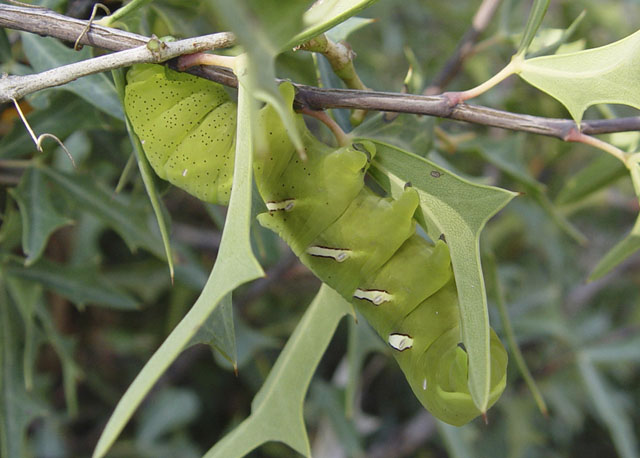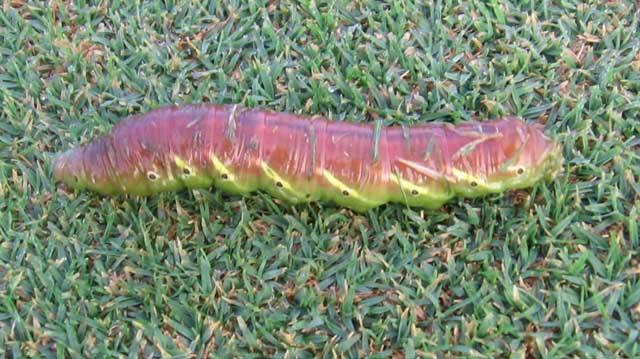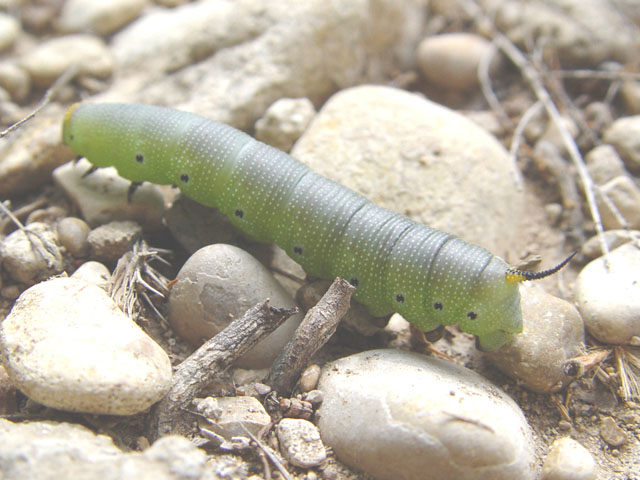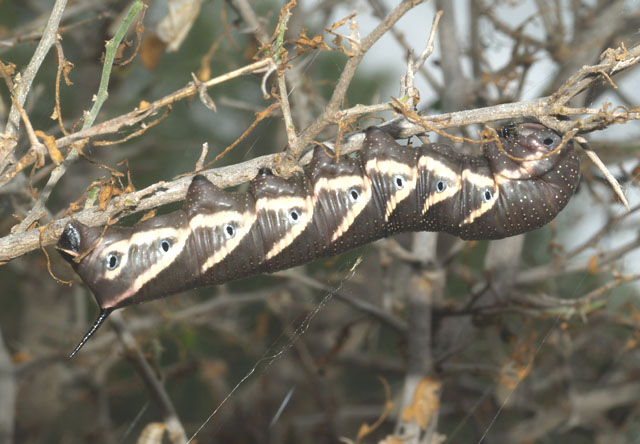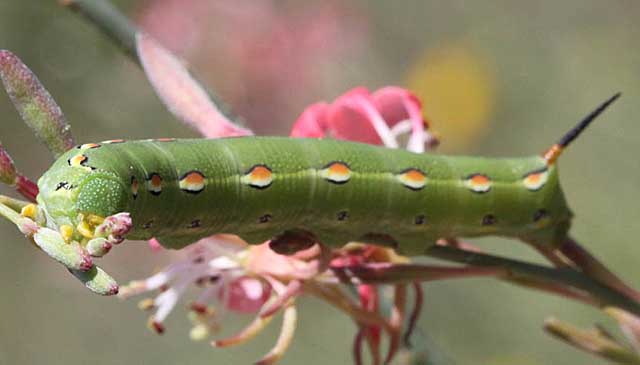Sphinginae subfamily
Sphingini tribe:
 |
Larvae feed on plants in the Convolvulaceae family, especially
Ipomoea batatas (sweet potato) and in the Solanaceae family,
especially (Datura) (jimsonweed) and related plants in the
Americas. There is also a brown form. Look for very large, dark
spiracular circles.
|
Agrius cingulata. Georgetown, Williamson Co., August 25, 2008, Jill Burrows
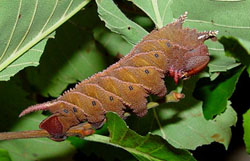 |
Ceratomia amyntor
USGS,
the Elm Sphinx or Four-horned Sphinx
Larvae feed on Elm (Ulmus), birch (Betula), basswood
(Tilia), and cherry (Prunus).
There are both green and brown forms. The four horns near
the head are diagnostic. |
 |
Young caterpillars feed gregariously on Catalpa species
(Catalpa bignoniodes and C. speciosa) in the
Bignoniaceae family, skeletonizing the foliage.
Larvae are mostly white in early instars.
generally more eastern species |
|
Ceratomia hageni
WO, Hagen's Sphinx or Osage Orange Sphinx
Larvae feed on osage orange (Maclura pomifera). No larval
image is available at this time.
generally more eastern species |
 |
Fraxinus, Ligustrum, Quercus, Crataegus and
Chionanthus virginicus are listed as hosts.
In the fifth instar, the spiracular ovals are decidedly red and the
anal horn is off-white to pinkish laterally.
|
 |
Dolba hyloeus
WO/MVB, the Pawpaw Sphinx
Larvae feed on pawpaw (Asimina triloba), littleleaf sweetfern
(Myrica aspleniifolia), possum haw (Ilex decidua), and
inkberry (Ilex glabra) as well as Tall Gallberry Holly
(Ilex coriacea).
Louis Handfield reports larvae probably feed on Ilex verticellata
in Quebec.
generally more eastern species
|
Dolba hyloeus on Ilex decidua, Kendall County, May 20, 2010, Mike Van Buskirk

|
Isoparce cupressi
USGS, Cypress or Baldcypress Sphinx.
Larvae feed on needles of baldcypress (Taxodium distichum) at night and
pupate in shallow underground burrows where second generation
overwinters.
|
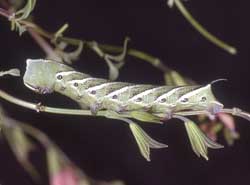 |
Lintneria eremitoides USGS. Larval hosts are Sage (Salvia species).
The Lintneria larvae will most often be encountered on Lamiaceae: Salvia (Sage), Mentha (Mints), Monarda (Beebalm) and
Hyptis (Bushmints); Verbenaceae: Verbena and Lantana camara (shrub verbenas or lantanas).
One is even more likely to discover larvae feeding in the evening or after dark.
|
| Larval hosts are unknown to me.
Sorry, no larval image is available at this time.
|
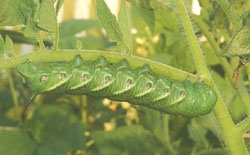
|
The caterpillars are called Tomato Hornworms and each has a black horn at the end of the abdomen.
Larvae feed on potato, tobacco, tomato, and other plants in the
nightshade family (Solanaceae). There is also a very beautiful brown form. See bottom of page.
|

|
The caterpillars are called Tomato Hornworms and each has a black horn at the end of the abdomen.
Larvae feed on potato, tobacco, tomato, and other plants in the
nightshade family (Solanaceae). There is also a very beautiful brown
form to the left.
|
Manduca quinquemaculatus, Georgetown, Williamson County, Jill Burrows.
 |
Manduca rustica
USGS/CV/MS-M, the Rustic Sphinx
The caterpillar has numerous white nodules on top of the thorax and
seven pairs of oblique, blue-gray stripes along the side of the body.
The horn is white at the base and blue-gray at the tip. Many hosts are utilized.
|
Manduca rustica, Austin, Texas, June 24, 2006, Chandra Volkmar.
Manduca rustica Georgetown (Williamson), Texas, September 13, 2007, Martha Stroud-Merry.
 |
Tobacco Hornworms, equipped with a red-tipped horn at the end of the
abdomen, are true gluttons and feed on tobacco and tomato, and
occasionally potato and pepper crops and other plants in the
nightshade family (Solanaceae).
|
Manduca sexta, Travis County, August 21, 2008, Trina Woodall. larva care
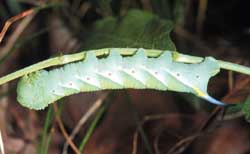 | Preferred hosts are common trumpetcreeper (Campsis radicans),
Florida yellow-trumpet (Tecoma stans), lilac
(Syringa species), and
passionflower (Passiflora species).
The anal horn is blue, preceded by a yellow dash.
|
 | Larval hosts are Alligator juniper (Juniperus deppeana)
and other juniper species.
|
 | Istar Sphinx larvae feed primarily on mints (Salvia).
|
 | Larvae feed on New Mexican forestiera
(Forestiera neomexicana), on Forestiera angustifolia
and on little leaf ash (Fraxinus gooddingii) in the Oleaceae
family. There are green and dark forms and all larvae tend to darken
just before pupation.
|
Smerinthini Tribe:
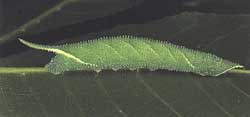 |
Amorpha juglandis larvae feed upon Walnut and butternut (Juglans),
hickory (Carya), alder (Alnus), beech (Fagus),
hazelnut (Corylus), and hop-hornbeam (Ostrya). |
Amorpha juglandis, Austin, May 13, 2010, courtesy of Suvi Aika.
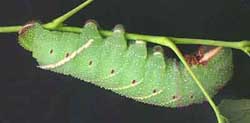 |
Pachysphinx modesta
USGS,
the Modest Sphinx or Poplar Sphinx
Larvae feed on poplars and cottonwood.
|
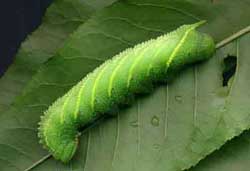 |
Larvae accept willows, birches, and cherries.
I have also found them in the wild on oak in eastern Canada. generally more eastern species |
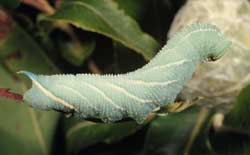 |
Larvae feed upon many forest trees including birches and cherries,
but are expecially fond of poplars and willows. Red markings on sides
vary greatly from specimen to specimen.
|
Macroglossinae subfamily
Dilophonotini tribe:
|
Larvae feed on various species of the Rubiaceae (madder) family.
Randia rhagocarpa, Randia monantha, Randia aculeata, Guettarda
macrosperma and Genipa americana are listed as hosts. Sorry, no larval image available at
this time. rare |
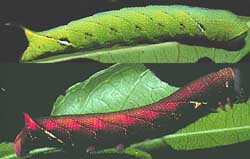 |
Larvae feed on various species of the Rubiaceae (madder) family,
including Genipa americana and Alibertia edulis
and Randia species. There are at least two color morphs, a green form and a
much darker, reddish-brown form. rare |
 |
Larvae feed on seven year apple, Casasia clusiifolia, common
buttonbush, Cephalanthus occidentalis, and white indigoberry,
Randia mitis. Randia monantha, Randia aculeata,
Albizzia adinocephala and Randia grandifolia, all in the
madder family (Rubiaceae), also serve as hosts. rare |
 |
Larvae feed on papaya (Carica papaya), Cnidoscolus
angustidens, poinsettia (Euphorbia pulcherrima),
guava (Psidium species) and
saffron plum (Bumelia angustifolia/Bumelia celastrina).
Manilkara bahamensis,
Willow Bustic (Bumelia salicifolia)
and Painted Leaf (Poinsettia heterophylla) are also hosts.
Nice socks! Larvae show considerable variation.
|
 |
Larvae feed on papaya (Carica papaya), Manihot esculenta
and various plants (Macroscepis obovata) in the milkweed
family.
might be present in southern portions of this region.
|
 |
Erinnyis obscura, the Obscure Sphinx,
USGS
Larvae feed on Rauvolfia ligustrina, Rauvolfia tetraphylla,
Stemmadenia obovata, Philibertia, Cynanchum, papaya
(Carica papaya), Asclepiadaceae, Blepharodon mucronatum,
White vine (Sarcostemma clausum) and Morrenia odorata.
rare
|
See Hemaris comparison to help distinguish
the next two species.
 |
Hemaris thysbe
WO, the Hummingbird Clearwing
There is also an orangey-pink prepupal form. The lateral line runs
from S1 to the blue horn.
Hemaris thysbe larvae feed on viburnum and related plants.
generally more eastern species
|
 |
Hemaris diffinis
USGS/ML/JB, the
Snowberry Clearwing or Bumblebee Moth
Larval host plants include Snowberry (Symphoricarpos),
honeysuckle (Lonicera), Coralberry, viburnums, Blue Dogbane
(Apocynum) and dwarf bush honeysuckle (Diervilla lonicera).
Horn is black with a yellow base.
|
Hemaris diffinis larva, April 20, 2006, Austin, courtesy of Melody Lytle.
Hemaris diffinis, Georgetown, Williamson County, October 18, 2002, Jill Burrows.
 |
Females feed and lay eggs on fig leaves, especially Strangler Fig
(Ficus aurea). Ficus carica, Ficus microcarpa, Ficus
religiosa, Ficus pumila, Ficus gamelleira, Ficus prinoides, Ficus
pumila and Artocarpus integrifolia are also listed as
hosts.
The extreme variability of larvae is shown to the left.
The few images that have been sent to me for identification help
are usually as per the upper image.
|
Philampelini tribe:
 |
Larvae feed upon Grape (Vitis), Virginia Creeper
(Parthenocissus quinquefolia) and other vines and ivies
(Ampelopsis).
Larvae occur in both a light (green) form and a darker (tan/brown)
form. Note six "segmented" oblique lines.
|
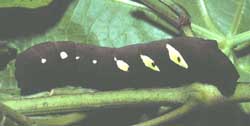 |
Cissus erosa and Vitis are reported hosts in Brazil.
This one is not likely to be seen in Texas. There is also a green form.
rare stray |
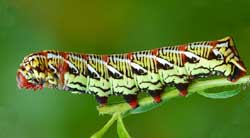 |
Eumorpha fasciatus
USGS, the Banded Sphinx
Larvae feed upon primrose-willow, Ludwigia (water primrose)
and other plants in the evening primrose family. This hornless larva is
highly variable. Look for large, dark spiracular circles and a dark
line in the center of the back. See image at bottom of this page.
|
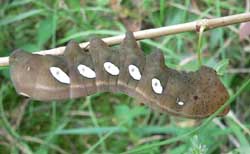 |
If you have Grape or Virginia Creeper nearby, then you might encounter
this species. Note the five large white ovals. There are orangey-brown and green
forms also.
generally more eastern species |
 |
Eumorpha vitis
USGS/Amy Smith/ML/LT,
the Vine Sphinx
Eumorpha vitis vitis larvae feed upon grape foliage (Vitis) and
other vines (Cissus): Cissus pseudosicyoides
and Cissus rhombifolia and Cissus sicycoides.
I suspect there would be a brown form.
Note five, smooth, narrow, oblique white lines.
|
Eumorpha vitis, Bulverde near San Antonio, Bexar
County, Amy Smith, October 5, 2005
Eumorpha vitis, Austin, Texas, September 19, 2005, courtesy of
Melody Lytle.
Eumorpha vitis, Converse, Bexar County, November 2008, Lisa Tingle.
Macroglossini tribe:
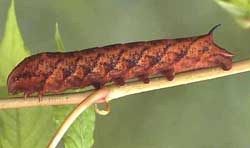 |
In additon to Virginia creeper larvae accept Grape (Vitis),
ampelopsis (Ampelopsis), and cayenne pepper (Capsicum).
Larvae are green until the final instar.
|
 |
Larvae feed on Azalea and Viburnum and progress very rapidly. The
larva to the left on Viburnum cassinoides is getting ready to
pupate. Color change from green to light burgundy-brown indicates
pupation is imminent. |
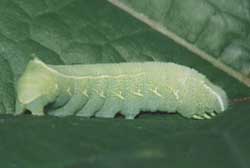 |
Darapsa myron USGS, the Virginia Creeper Sphinx or the Grapevine Sphinx
If you have the
foodplants indicated in the common names, you probably have this
species nearby. The lower wings are orange.
Larvae feed on Virginia creeper (Parthenocissus quinquefolia),
Grape (Vitis), Ampelopsis, and Viburnum. |
 |
Hyles lineata
USGS/ML, the White-lined Sphinx
Larvae are highly varied and feed on a great diversity of plants
including willow weed (Epilobium), four o'clock (Mirabilis),
apple (Malus), evening primrose (Oenothera), elm
(Ulmus), grape (Vitis), tomato (Lycopersicon),
purslane (Portulaca), and Fuschia.
All larvae seem, however, to have the red/black swellings split by
dorso-lateral lines. |
Hyles lineata, Lady Bird Johnson Wildflower Center, Austin, May 29, 2010 Melody Lytle.
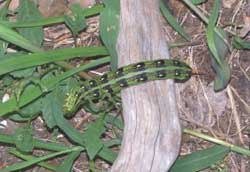
| Hyles lineata: larva sighting, Cedar Park near
Austin, Texas, May 3, 2006, by Katherine Green who writes,
"I think it is Hyles lineata, but from the other pictures I am
not sure. It is making a meal of my Pink Primroses. I watched for a
bit and it steard clear of the grass, red yucca and wandering jew."
This larva is highly variable, but the lateral "circles" are fairly consistent. |
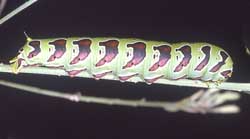 | Larvae feed on (Onagraceae) including evening primrose
(Oenothera), gaura (Gaura), and willow weed
(Epilobium).
rare
|
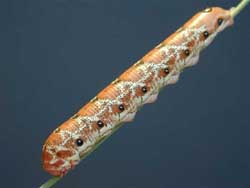 |
Larvae feed on (Onagraceae) including evening primrose
(Oenothera), gaura (Gaura), and willow weed
(Epilobium).
rare
|
 |
Larvae feed at night on grape (Vitis) and ampelopsis
(Ampelopsis) and hide on the bark of their host plants during
the day. Virginia creeper would also be a suitable host. There is also a dark form
without the green patches. Note the "raised eye", replacing the anal horn.
generally more eastern species
|
 |
Larvae also feed on Borreria, Catalpa and Manettia spp. and
Smooth buttonplant (Spermacoce glabra) and starclusters
(Pentas species). They are also recorded on joe-pie weed and
Hamelia patens and on Hedoydis nigricans. The green form may be more common.
|
Xylophanes tersa, Georgetown, Williamson County, October 18, 2002, Jill Burrows.
Xylophanes tersa, Austin, Travis County, October 5, 2009, Jacque Austin.
|
|


